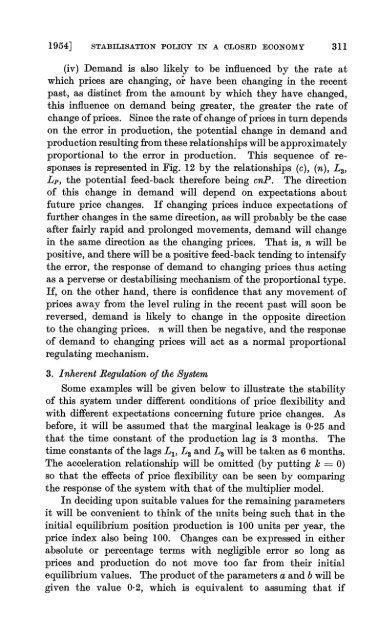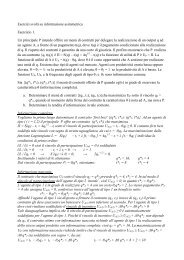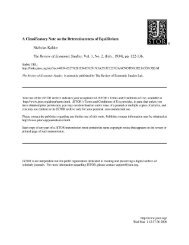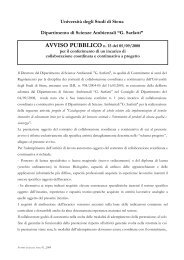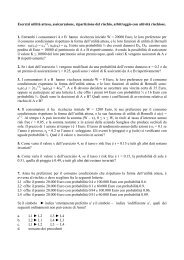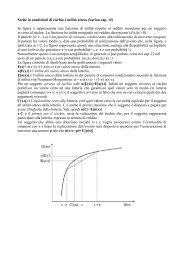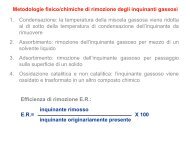Stabilisation Policy in a Closed Economy Author(s): A. W. Phillips ...
Stabilisation Policy in a Closed Economy Author(s): A. W. Phillips ...
Stabilisation Policy in a Closed Economy Author(s): A. W. Phillips ...
Create successful ePaper yourself
Turn your PDF publications into a flip-book with our unique Google optimized e-Paper software.
1954] STABILISATION POLICY IN A CLOSED ECONOM Y 311<br />
(iv) Demand is also likely to be <strong>in</strong>fluenced by the rate at<br />
which prices are chang<strong>in</strong>g, oi have been chang<strong>in</strong>g <strong>in</strong> the recent<br />
past, as dist<strong>in</strong>ct from the amount by which they have changed,<br />
this <strong>in</strong>fluence on demand be<strong>in</strong>g greater, the greater the rate of<br />
change of prices. S<strong>in</strong>ce the rate of change of prices <strong>in</strong> turn depends<br />
on the error <strong>in</strong> production, the potential change <strong>in</strong> demand and<br />
production result<strong>in</strong>g from these relationships will be approximately<br />
proportional to the error <strong>in</strong> production. This sequence of re-<br />
sponses is represented <strong>in</strong> Fig. 12 by the relationships (c), (n), L3,<br />
Lp, the potential feed-back therefore be<strong>in</strong>g cnP. The direction<br />
of this change <strong>in</strong> demand will depend on expectations about<br />
future price changes. If chang<strong>in</strong>g prices <strong>in</strong>duce expectations of<br />
further changes <strong>in</strong> the same direction, as will probably be the case<br />
after fairly rapid and prolonged movements, demand will change<br />
<strong>in</strong> the same direction as the chang<strong>in</strong>g prices. That is, n will be<br />
positive, and there will be a positive feed-back tend<strong>in</strong>g to <strong>in</strong>tensify<br />
the error, the response of demand to chang<strong>in</strong>g prices thus act<strong>in</strong>g<br />
as a perverse or destabilis<strong>in</strong>g mechanism of the proportional type.<br />
If, on the other hand, there is confidence that any movement of<br />
prices away from the level rul<strong>in</strong>g <strong>in</strong> the recent past will soon be<br />
reversed, demand is likely to change <strong>in</strong> the opposite direction<br />
to the chang<strong>in</strong>g prices. n will then be negative, and the response<br />
of demand to chang<strong>in</strong>g prices will act as a normal proportional<br />
regulat<strong>in</strong>g mechanism.<br />
3. Inherent Regulation of the System<br />
Some examples will be given below to illustrate the stability<br />
of this system under different conditions of price flexibility and<br />
with different expectations concern<strong>in</strong>g future price changes. As<br />
before, it will be assumed that the marg<strong>in</strong>al leakage is 0-25 and<br />
that the time constant of the production lag is 3 months. The<br />
time constants of the lags L1, L2 and L3 will be taken as 6 months.<br />
The acceleration relationship will be omitted (by putt<strong>in</strong>g k _ 0)<br />
so that the effects of price flexibility can be seen by compar<strong>in</strong>g<br />
the response of the system with that of the multiplier model.<br />
In decid<strong>in</strong>g upon suitable values for the rema<strong>in</strong><strong>in</strong>g parameters<br />
it will be convenient to th<strong>in</strong>k of the units be<strong>in</strong>g such that <strong>in</strong> the<br />
<strong>in</strong>itial equilibrium position production is 100 units per year, the<br />
price <strong>in</strong>dex also be<strong>in</strong>g 100. Changes can be expressed <strong>in</strong> either<br />
absolute or percentage terms with negligible error so long as<br />
prices and production do not move too far from their <strong>in</strong>itial<br />
equilibrium values. The product of the parameters a and b will be<br />
given the value 0-2, which is equivalent to assum<strong>in</strong>g that if


